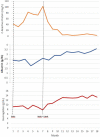Dual Biologic Therapy in an Adolescent With Camurati-Engelmann Disease and Crohn Disease
- PMID: 37168741
- PMCID: PMC10158315
- DOI: 10.1097/PG9.0000000000000169
Dual Biologic Therapy in an Adolescent With Camurati-Engelmann Disease and Crohn Disease
Abstract
Camurati-Engelmann disease (CED) is a rare disorder caused by activating mutations in the TGF-β1 gene and characterized by hyperostosis of long bones and bone dysplasia. We describe a case of an adolescent with CED and moderate-severe Crohn Disease (CD). Infliximab improved gastrointestinal symptoms but was associated with worsening CED-associated bone pain. Clinical remission was successfully achieved with dual biologic therapy that included vedolizumab and ustekinumab. Possible reasons for this patient's clinical response are advanced and include speculation about the complex role of TGF-β1 signaling in the etiology of both CED and CD.
Keywords: TGF-β1; inflammatory bowel disease; ustekinumab; vedolizumab.
Copyright © 2022 The Author(s). Published by Wolters Kluwer Health, Inc. on behalf of the European Society for Pediatric Gastroenterology, Hepatology, and Nutrition and the North American Society for Pediatric Gastroenterology, Hepatology, and Nutrition.
Conflict of interest statement
A.S.S. report no conflicts of interest. J.R.R. received grant/research from Abbvie, Janssen; and advisor/consultant from BMS, Celgene, Janssen, Lilly, Pfizer.
Figures
References
-
- Saito T, Kinoshita A, Yoshiura KI, et al. . Domain-specific mutations of a transforming growth factor (TGF)-β1 latency-associated peptide cause Camurati-Engelmann disease because of the formation of a constitutively active form of TGF-β1. J Biol Chem. 2001;276:11469–11472. - PubMed
-
- Ihara S, Hirata Y, Koike K. TGF-β in inflammatory bowel disease: a key regulator of immune cells, epithelium, and the intestinal microbiota. J Gastroenterol. 2017;52:777–787. - PubMed
-
- McCabe RP, Secrist H, Botney M, et al. . Cytokine mRNA expression in intestine from normal and inflammatory bowel disease patients. Clin Immunol Immunopathol. 1993;66:52–58. - PubMed
Publication types
LinkOut - more resources
Full Text Sources



